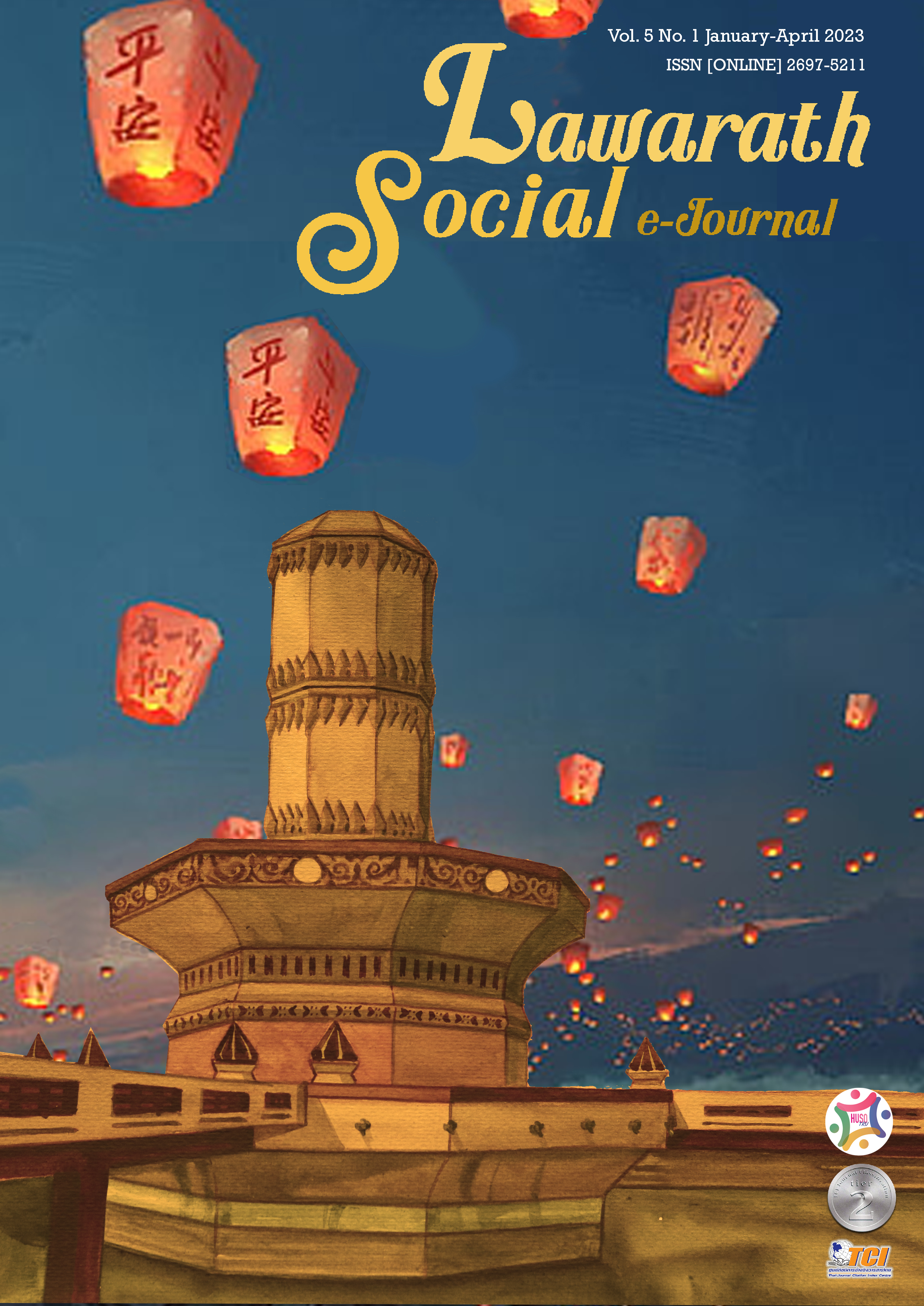汉语生肖兔四字成语隐喻研究及汉语教学意义
คำสำคัญ:
生肖兔, 成语语义, 隐喻, 文化形象, 汉语教学บทคัดย่อ
目前,国内外已有对十二生肖成语文化内涵、语义、隐喻等的研究,但专门针对每个动物生肖的成语内涵及隐喻的研究还不多,且还没有对“兔”成语隐喻的研究。兔是中国文化中一个重要的动物形象,因此,关于生肖兔相关成语的隐喻情况值得我们深入研究。本文整理汉语成语词典中的“兔”成语用例并以此为语料,先对兔的各项语义进行归纳和分析,然后从概念隐喻的角度出发,对汉语“兔”成语的隐喻源域和目标域,以及隐喻类型进行深入剖析,从而探究其隐喻情况及文化意义,了解汉语“兔”成语的隐喻工作机制及特点。通过研究笔者得出生肖兔成语隐喻映射情况、具体隐喻类型及隐喻内涵等结论,即:1.生肖兔相关成语使用了“兔”作为哺乳动物本身可食用可制作衣物、神话动物“月兔”、兔的外貌体态、兔的行为动作、兔的性格习性等特征作为成语主要语义;2.生肖兔成语以上述语义为隐喻源域,映射到目标域“人、事物、事理”中;3.通过隐喻生动体现了人的行为动作、处世方式、外貌、性格、心理,以及时间、事理等抽象概念;4.生肖兔成语隐喻以结构隐喻和实体隐喻为主要类型,同时兼具方位隐喻;5.当生肖兔与其它动物共现于同一成语形式中时具有独特的隐喻义,且大部分同一词组形式的成语其隐喻方式基本相同;6.通过隐喻分析帮助我们了解了生肖兔在中国文化中的形象与内涵。最终根据研究结果从隐喻分析和文化意义的角度为汉语国际教育中成语的教学提出建议。
References
Chen, Ch. (2020). Comparison of Chinese and Korean Animal Idioms. Master’s thesis, Nanjing Normal University.
Gao, W. (2012). Teaching Strategies of Animal Metaphors in Foreign Language Teaching. Master’s thesis, Northwest University.
Goatly, A. (2006, February). Humans, Animals, and Metaphors. Society & Animals: Journal of Human-Animal Studies, 14(1), 15-37.
Huang, B., &Liao, X. (2002). Xiandai Hanyu. China: Higher Education Press.
Institute of Linguistics, CASS. (2002). The Contemporary Chinese Dictionary (Chinese-English Edition). China: Foreign Language Teaching and Research Press.
Khemcharoen, C. (2015). A Contrastive Study on Images of Animal in Chinese and Thai Idioms. Master’s thesis, Dalian University of Technology.
Lakoff, G., &Johnsen, M. (1980). Metaphors We Live By. London: The University of Chicago press.
Li, Sh. (2011, March). The Metaphorical Scope of "Rabbit" Idiom. MODERN COMMUNICATION, 2011(03), 104.
Li, X. (2006, December). A Cultural Perspective on Chinese-English Animal Metaphors. Journal of Hunan University of Science and Engineering, 2006(12), 117-119.
_______. (2018). The Comparison of Animal Idioms between China and South Korea in Metaphorical Perspective. Master’s thesis, Shanxi Normal University.
Liu, Sh. (2014). A Study of Idioms of Chinese Zodiac Animals. Master’s thesis, Nanjing Normal University.
Liu, T. (2010). Cognitive Metaphor of Chinese Idioms. Master’s thesis, Inner Mongolia Normal University.
Liu, Y., &Fan, R. (2015, June). Exploring the Teaching of Idioms in Chinese as a Foreign Language from a Metaphorical Cognitive Perspective. Survey of Education, 2015(06), 53-55.
_______. (2015). The Advanced Stage in Idiom Teaching for Chinese as The Second Language Based on The Metaphor Cognitive. Master’s thesis, Northeast Normal University.
Pan, R. (2014). A Comparative Study of Animal Metaphors in Chinese and English Idioms. Master’s thesis, Yunnan Normal University.
Shu, D. (1998, December). On the Nature and Semantic Characteristics of Metaphors. Journal of Foreign Languages, 1998(12), 10-19.
_______. (2000). Studies in Metaphor. Shanghai: Shanghai Foreign Language Education Press.
_______. (2002, March). On the Operation Mechanism of Metaphor. Foreign Language Teaching and Research(bimonthly), 2002(3), 98-106.
Solongo, L. (2013). Comparation of Human Body Phraseology’s in Chinese and Mongolian. Doctoral dissertation, Northeast Normal University.
Suksomboonwong, W. (2018). The Comparative Study of Metaphor in Chinese and Thai Diet Words. Doctoral dissertation, Central China Normal University.
Tang, T. (2014). Study on Idiom Teaching in TCSL Based on Metaphor Theory—Take Spatial Metaphorical Idioms for Example. Master’s thesis, East China Normal University.
The Commercial Press. (2013). Chengyu Da Cidian. Beijing: The Commercial Press.
_______. (2019). Zhonghua Chengyu Da Cidian (2nd ed.). Beijing: The Commercial Press.
_______. (2013). XINHUA CHENGYU DA CIDIAN. Beijing: The Commercial Press.
Wang, J. (2012). Study on Plant Idioms in Chinese – from the Perspective of Metaphor. Master’s thesis, Shanghai Jiao Tong University.
Wang, Y., &Li, H. (2004, November). “Three-in-one” Teaching view of language ability, communicative ability and metaphor ability——The application of metaphorical cognitive theory in foreign language teaching. Journal of Sichuan International Studies University, 2004(11), 140-143.
Xiang, Ch., &Wang, M. (2009, March). A Cross-Cultural Study of Animal Metaphors in English and Chinese. Modern Foreign Languages, 2009(3), 6.
Xie, L. (2011, January). Cognitive Mechanisms of Metaphor and Metonymy in Chinese four-character Idioms. Journal of Language and Literature Studies, 2011(01), 84 & 109.
Xu, R. (2015). Teaching Idioms in Teaching Chinese as a Foreign Language: An Animal Metaphors Perspective. Master’s thesis, Harbin Normal University.
Yu, J., &Piao, M. (2014, April). A Study on the Perception of Animal Idiom Metaphors. Journal of Shenyang Normal University (Social Science Edition), 2014(04), 109-111.
Yue, H., &Li, L. (2006, January). An Analysis of The Linguistic Expression and Semantic System of Animal Metaphor Words. Social Science Front, 2006(01), 304-306.
Zhao, Y. (1995, July). The Metaphorical Cognitive Structure of Language - Review on “The Metaphors We Live By”. Foreign Language Teaching and Research, 1995(07), 67-72.
Zhu, X. (2012). Metaphor Study for the Female Idioms of Chinese. Master’s thesis, Northeast Normal University.
Downloads
เผยแพร่แล้ว
How to Cite
ฉบับ
บท
License

This work is licensed under a Creative Commons Attribution-NonCommercial-NoDerivatives 4.0 International License.


